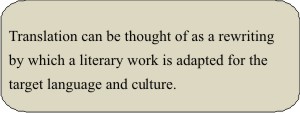| |
Introduction
We have already seen how translation can be between two forms of the sam e language, between two different languages or between two different art forms. We have also seen how difficult it is to demarcate translation from rewriting especially when this occurs within the same language. However, even interlingual translation can be seen as rewriting, a paradigm that was popularized by Andre Lefevere. He argued that translation can be perceived as a form of rewriting. In a seminal essay “Beyond Interpretation” or the Business of (Re)Writing” published in 1987, Lefevere states: “Rewritings, in the most catholic sense of the term, are designed to adapt works of literature to a given audience and/or to influence the way in which readers read a work of literature” (30), and that “The most obvious example of rewriting is probably translation, which either tends to represent a compromise between two sets of ideologies/poetics, or else tends to be used as a weapon in the struggle between competing ideologies/poetics within the same literary system” (31). e language, between two different languages or between two different art forms. We have also seen how difficult it is to demarcate translation from rewriting especially when this occurs within the same language. However, even interlingual translation can be seen as rewriting, a paradigm that was popularized by Andre Lefevere. He argued that translation can be perceived as a form of rewriting. In a seminal essay “Beyond Interpretation” or the Business of (Re)Writing” published in 1987, Lefevere states: “Rewritings, in the most catholic sense of the term, are designed to adapt works of literature to a given audience and/or to influence the way in which readers read a work of literature” (30), and that “The most obvious example of rewriting is probably translation, which either tends to represent a compromise between two sets of ideologies/poetics, or else tends to be used as a weapon in the struggle between competing ideologies/poetics within the same literary system” (31).
Lefevere’s concept of translation as a rewrite of the source text became an accepted concept in the field of Translation Studies eventually. He conceptualized translation as part of a larger literary system, as a process which could be understood fully only when placed against its socio-cultural context. Another term that was coined by Lefevere and gained currency in the field was “refraction”, or “the adaptation of a work of literature to a different audience, with the intention of influencing the way in which that audience reads the work” (Translation Studies Reader, 234 – 235). This is obviously how he also defines rewriting. Translation was a ‘refraction’ of a writer’s work through a certain spectrum, where the prism that refracts could be the translator’s ideology or other socio-cultural factors of the target language.
|